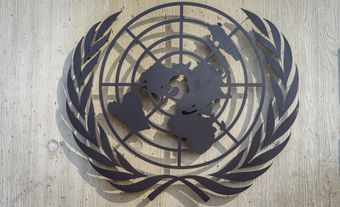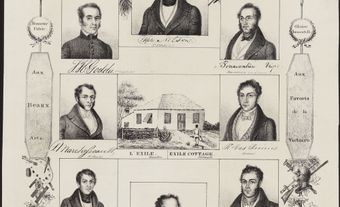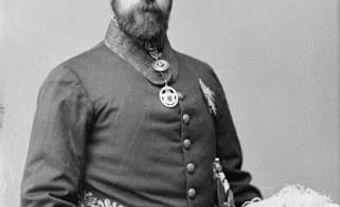This article was originally published in Maclean's Magazine on October 7, 1996
Israel Opens Disputed Tunnel
It was not the tunnel itself so much as the timing. The opening of a new exit to an underground pathway in ancient Jerusalem last week was like "throwing a burning match into an area filled with flammable material," wrote the influential Israeli daily newspaper Ha'aretz. For hardline Israeli Prime Minister Binyamin Netanyahu, giving a green light to the long-postponed tunnel was an assertion of the de facto sovereignty Israel has held over all parts of the once-divided city since the 1967 Six-Day War. For Palestinian leader Yasser Arafat, it became the cue to rouse his people's anger and frustration over the three-month-old Israeli government's failure to honor both the letter and the spirit of the 1993 Oslo accords.
At issue is access to an 80-yard aqueduct, discovered by British explorer Charles Warren in 1867. It lay mud-filled and forgotten under the Old City until nine years ago. At that time, Israel's ministry of religious affairs dug out the ancient water pipeline and linked it to the Western Wall tunnel, a much grander 500-yard passageway that exposes the underground length of the Western (Wailing) Wall - Judaism's holiest shrine - which runs along one side of the Al Aqsa compound - Islam's third holiest site. For two decades, archeologists have conducted delicate excavations around the Temple Mount, mindful of the religious sensibilities of Jews, Christians and Muslims. A Muslim council controls the top of the Temple Mount area. Known as Haram al-Sharif (Noble Sanctuary) in Arabic, it contains the Al Aqsa Mosque and the gold-topped Dome of the Rock, from where Muhammad is believed to have ascended to heaven.
Israel's tourism ministry promotes the excavated site as a "time tunnel" taking visitors through 2,500 years of history. The traveller trudges beside the Western Wall along the cool, damp stones of a street built by King Herod 2,000 years ago - and where Jesus may well have walked. The path then leads through huge subterranean vaults created by Muslim Mamluks 12 centuries later. There is a medieval cistern, a gateway to the Temple Mount constructed by Muslims of an earlier era, and finally a peek at the water system.
The final passage is less than three feet wide, severely limiting traffic flow. Until last week, the layout also forced visitors to enter and exit the entire tunnel complex by the same route. Three years ago, building began on a new exit out to the Via Dolorosa, where Jesus bore his cross. By opening the new exit, say Israeli tourism officials, the number of visitors to the site will rise from 70,000 to 400,000 a year, eliminating the need to reserve months in advance.
The short new tunnel was completed a year and a half ago, but the previous Labour government delayed its opening so as not to antagonize its Palestinian partners in the peace process. Last January, Israel offered the Palestinians a deal, increasing Muslim rights on the Temple Mount in return for opening the gate. The Palestinians never formally agreed, former Labour cabinet minister Yossi Beilin told Maclean's - contrary to claims by the current Israeli government. With loose ends still lingering, and in light of last spring's wave of suicide bombings by Islamic militants and Israel's harsh countermeasures, then-Prime Minister Shimon Peres again put the project on hold. Last week, Netanyahu overrode the continuing concerns of security forces and gave the exit the go-ahead.
Although the tunnel complex - including its new exit - runs near the Temple Mount, it does not end inside it or violate any shrines. Nor is it open for traffic on Friday, the Muslim sabbath. The wily Arafat, however, still used the opening day to accuse Israel of violating Muslim holy sites, an allegation that hit a nerve among local Palestinians and gained them support across the Arab world. "The tunnel was not the real reason [for the violence]," said Ehud Barak, a former Israeli army chief of staff, while on a one-day visit to Toronto last week. It was, he said, a demonstration by the Palestinian Authority "that they have the leverage to raise the tension level." Still, Arafat insists the tunnel decision undermined assurances by Netanyahu's predecessors that no changes would be made in Jerusalem until its final status was eventually negotiated.
A furious Netanyahu, on a trip to Europe, accused Arafat of waging a campaign of "deliberate disinformation" to inflame Palestinian passions. But as many Palestinians and Israelis pointed out, the tunnel issue was the spark in an already explosive situation. To Palestinian parliamentarian Hanan Ashrawi, a former peace negotiator, the fight was not over the tunnel. "It is a fight over the soul of Jerusalem and the legitimacy of the peace process," she said. Ex-prime minister Peres scolded Netanyahu's timing. "Nothing was urgent," Peres said. "It waited for 2,000 years. It could have waited for another year or so." Netanyahu has pledged that Jerusalem - which Palestinians as well as Jews claim as their capital - will never again leave Jewish control. His decision to open the historic tunnel may have opened the latest in 3,000 years of battles over the holy city.
Maclean's October 7, 1996

 Share on Facebook
Share on Facebook Share on X
Share on X Share by Email
Share by Email Share on Google Classroom
Share on Google Classroom


